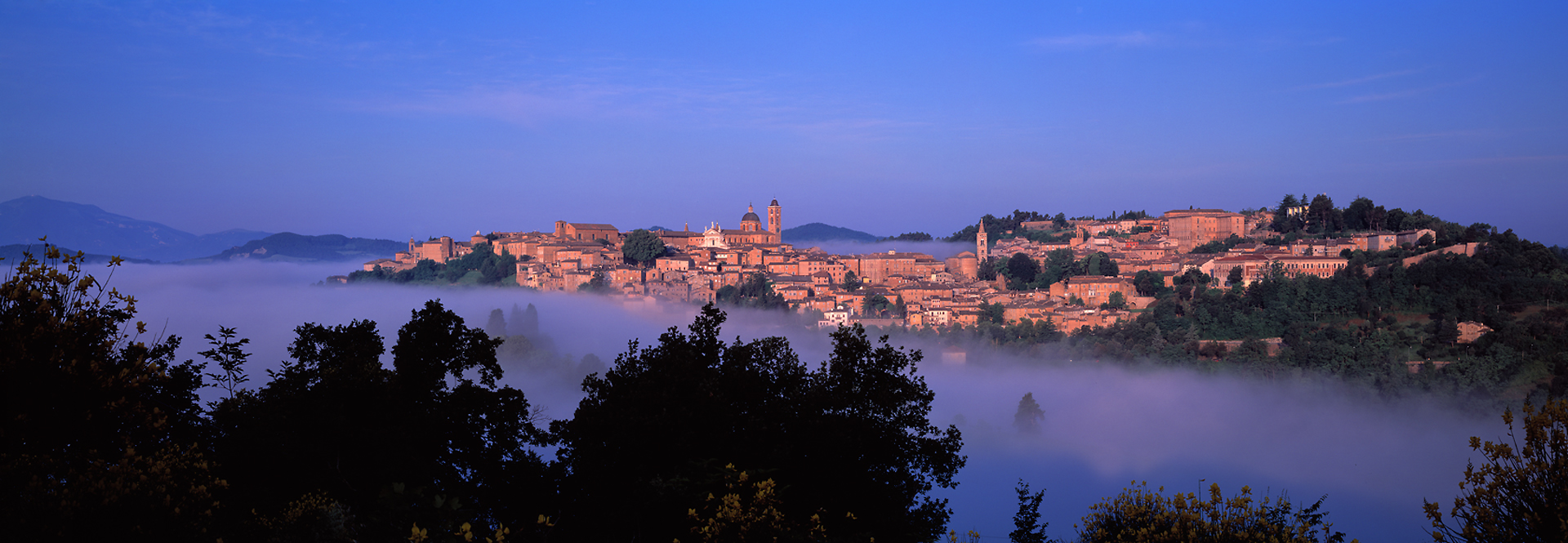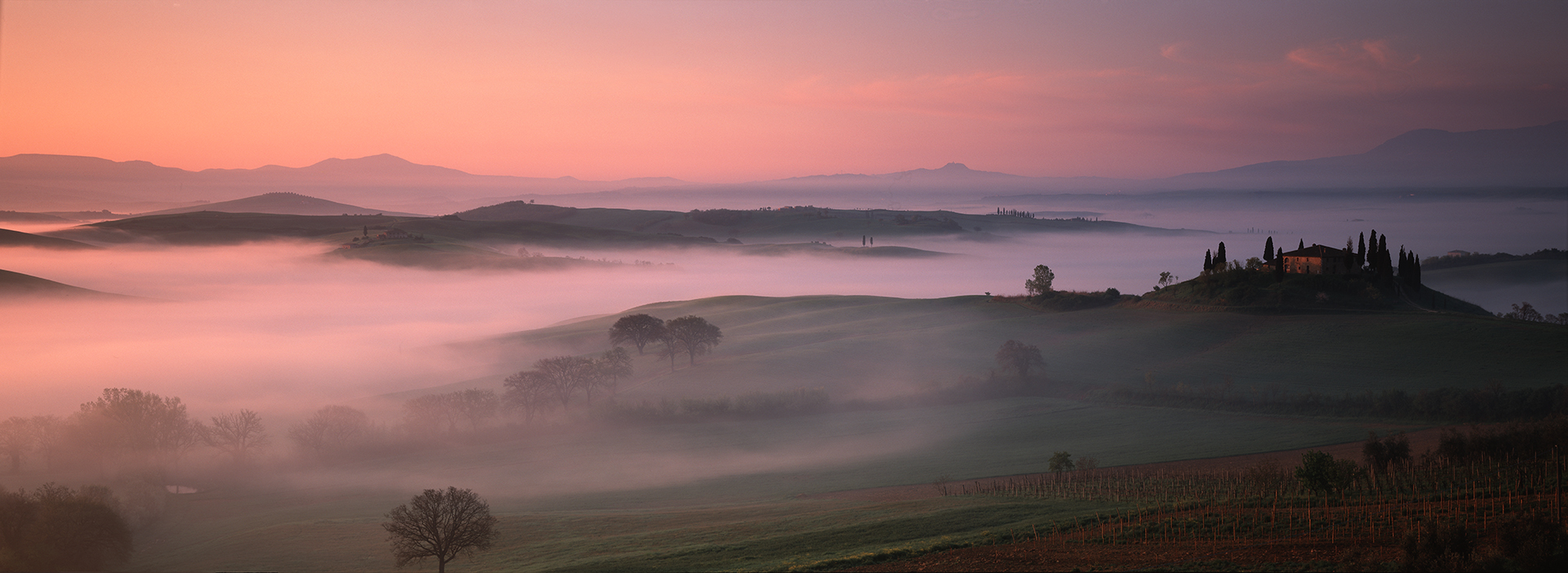Welcome to the second post in my series “History in Focus” where I feature the happy combination of a beautiful place, a rich history and a single successful photograph.

The Place
We are looking at Urbino, in the region of Le Marche. It is on the unfashionable eastern side of the Apennines, in rolling hills between the high mountains and the coastal plain where the rivers run towards the Adriatic. The countryside is as pretty as anything in Tuscany or Umbria. They make decent wine, and the white wines of Jesi are moderately well known.
Great events of history have, by and large, passed Le Marche by. Yes, in antiquity one of the major routes north from Rome, the Via Flaminia, wound over the mountains here. But the going was still hard, and in comparatively recent history if you wanted to get from Rome to – say – Ancona on the Adriatic coast, you might have been better served going by sea.
The region lacks the extraordinary fertility of the Po Valley, was the centre of no mighty ancient civilisation, and the trade routes that passed through it were of the second order at best. Empires did not often fight over it. Its location, in short, did not create the environment for an economic or strategic powerhouse. And yet one of Italy’s jewels is found here.
The History
Urbino seems almost too perfect to be true. The town, stretched along its ridge, and its major buildings, look like illustrations from a fairy tale or a romance. The painter Raphael was born and served his apprenticeship here. Its court was where one of the classics of Renaissance literature was written. Its palace is a jewel box of architecture and art. It was ruled by an archetypal Renaissance philosopher-prince, a stern warrior with a humanist education who patronised artists and intellectuals and assembled one of the greatest libraries outside the Vatican. In almost every respect, it could be considered an exemplar of Renaissance ideals – an ideal ruler in an ideal court in an ideal city. And its greatness came and went quickly – its light burned briefly, but brightly.
Urbino was a Roman city in antiquity, but was close enough to the late Roman capital of Ravenna to suffer in the wars between Byzantines and Goths, and during the Lombard invasions. One comes across few references to it in most histories of the Middle Ages, and at the end of that era the impression is of a provincial capital whose ruling family controlled enough territory to make a few advantageous dynastic marriages in the immediate region, but for whom greatness did not obviously beckon.
Then, in the mid-15th Century, along came Federico da Montefeltro, Duke of Urbino. He was the bastard son of a former duke, and the title was first inherited by his half-brother. Federico set out on one of the standard careers for such young men, as a condottiere or mercenary leader, selling his services in the interminable wars of the period to the leaders of wealthy states such as Milan and Naples, or indeed the Pope.
As it turned out he was very successful at this profession, which proved to be useful. For when he assumed the dukedom on the death of his half-brother, he inherited a minor duchy whose finances were not in a good state. But the considerable income from his military activities, combined with the bargaining power of being a competent general at the head of a loyal and disciplined force, meant that Urbino was suddenly punching above its weight.
Having a humanist education, Federico enthusiastically embraced the ideals of the Renaissance, governing his small duchy justly based on the best examples of the classical world. Painters, scholars and architects were all attracted to his court. A classic of Renaissance literature, Il Cortigiano (The Courtier) by Baldessare Castiglione, was written there and described an ideal court, based in good part on Federico’s actual court. It was hugely influential throughout Europe in describing what it meant to be a gentleman, when that had come to mean more than just landed wealth and skill at arms, but manners, learning and culture as well.
Urbino’s position in our imaginations as the exemplar of so much that was admirable about the Renaissance has been around for a while. It started with Castiglione, but Castiglione’s line was enthusiastically taken up by the man who really invented the modern idea of the Renaissance – the 19th Century Swiss historian Jacob Burckhardt. The legend of Urbino was given a further enthusiastic endorsement by Kenneth Clark in his seminal 1970s BBC television series Civilisation. (A few years ago the series was remastered in high definition from the original 35mm film stock – it occasionally turns up on streaming services and is worth looking out for.)
Modern historians point out, correctly, that the greatest architect of the legend of Federico the warrior-philosopher-prince was Federico himself. That’s true; he was a careful curator of his own legacy. But that doesn’t make him a fake – there is no evidence that he did not genuinely aspire to be the person he wanted to be remembered as.
But Federico’s son died without heir, the duchy passed to a family allied to the Papacy, and before long Urbino became part of the Papal States and entered the long economic and intellectual decline that came with it. Paradoxically, like other places in Central Italy, it was just that sudden reversion to a backwater which preserved the city for us much as it was during those glory days. These days Urbino is a university town which gives it a sense of intellectual energy very much in keeping with its past.
The Photograph
This photograph was the product of good planning and good fortune. Of course, having done the former makes it more likely that you will be in a position to take advantage of the latter.
We were staying a couple of dozen kilometres away near a small town called Isola del Piano, and it was a quick trip over fairly decent back roads from there to Urbino. The evening before I took the photograph, we drove over to Urbino and I picked a spot which had a good view of the city. In addition, I had a compass with me and a table for that time of year showing the time of sunrise, and the azimuth of the sun at dawn. It seemed likely that, given good conditions in the morning, the city would be illuminated over my right shoulder by the rising sun. I marked the position on my satnav. These days I have an app on my smartphone which does all that!
I set the alarm for an hour or so before sunrise the next morning, and crept out taking all my large format camera gear with me. Arriving at the spot I spent half an hour or so setting up and composing the picture; I had chosen to use a 6x17cm rollfilm back on the Horseman camera to give me a panoramic format, and a slightly wide-angle lens.
And this is where the good fortune comes in. It had rained quite heavily the day before, but the morning proved to be fine. As the light slowly increased, I realised that the valleys were filled with mist. This not only meant that various main roads, petrol stations and other modern buildings were hidden, but the magical city of Urbino, which floats in our imagination as an embodiment of the Renaissance ideal, was transformed into an island floating in a sea of cloud. The cloud started burning off quite quickly once the sun hit it, so I only had a few minutes in which to take pictures at various exposures. In this version I used a long exposure to smooth out the movement of the cloud, and a 2-stop neutral density graduated filter to bring the brightness of the sky and the land closer together, as it would be perceived by the human eye.

